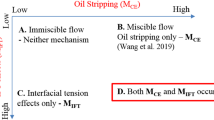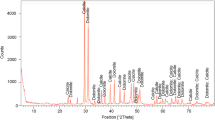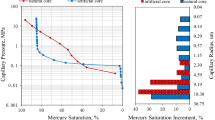Abstract
Adding surfactant into the displacing aqueous phase during surfactant-enhanced aquifer remediation of NAPL contamination and in chemical flooding oil recovery significantly changes interfacial tension (IFT) (σ) on water–oil interfaces within porous media. The change in IFT may have a large impact on relative permeability for the two-phase flow system. In most subsurface flow investigations, however, the influence of IFT on relative permeability has been ignored. In this article, we present an experimental study of two-phase relative- permeability behavior in the low and more realistic ranges of IFT for water–oil systems. The experimental work overcomes the limitations of the existing laboratory measurements of relative permeability (which are applicable only for high ranges of IFT (e.g., σ > 10−2 mN/m). In particular, we have (1) developed an improved steady-state method of measuring complete water–oil relative permeability curves; (2) proven that a certain critical range of IFT exists such that IFT has little impact on relative permeability for σ greater than this range, while within the range, relative permeabilities to both water and oil phases will increase with decreasing IFT; and (3) shown that a functional correlation exists between water–oil two-phase relative permeability and IFT. In addition, this work presents such correlation formula between water–oil two-phase relative permeability and IFT. The experimental results and proposed conceptual models will be useful for quantitative studies of surfactant-enhanced aquifer remediation and chemical flooding operations in reservoirs.
Similar content being viewed by others
References
Ahmed T.: Reservoir Engineering Handbook. 2nd edn. Gulf Professional Pub., Boston (2001)
Asar, H., Handy, L.L.: Influence of interfacial tension on gas-oil relative permeability in a gas-condensate system, SPE-11740. Presented at the 1983 California regional, Ventura, California, 23–25 March 1983, SPERE, February, pp. 687–698 (1988)
Bardon C., Longeron D.: Influence of very low interfacial tensions on relative permeability. Soc. Pet. Eng. J. 20, 391–401 (1980)
Brooks R.H., Corey A.T.: Hydraulic Properties of Porous Media. Hydrology Papers No. 3. Colorado State University, Ft. Collins (1964)
Brooks R.H., Corey A.T.: Properties of porous media affecting fluid flow. J. Irrig. Drain. Div. 6, 61–88 (1966)
Brooks, C.S., Purcell, W.R.: Surface area measurements on sedimentary rocks, SPE222-G. Presented at the fall meeting of the petroleum branch, American Institute of Mining and Metallurgical Engineers, Houston, 1–3 October 1952
Chisholm, J.T., Kashikar, S.V., Knapp, R.M., Menzie, D.E., Silfanus, N.J.: Microbial enhanced oil recovery: interfacial tension and gas-induced relative permeability effects, SPE-20481. This paper was prepared for presentation at the 65th annual technical conference and exhibition of the society of petroleum engineers held in New Orleans, LA, pp. 16–176, 23–26 September 1990
Conway, M.W., Smith, K., Thomas, T., Schrau, R.A.: The effect of surface active agents on the relative permeability of brine and gas in porous media, SPE-28982. Presented at the SPE international symposium on oilfield chemistry held in San Antonio, TX, pp. 395–401, 14–17 February 1985
Falta W.R., Pruess K., Javandel I., Witherspoon P.A.: Numerical modeling of steam injection for the removal of nonaqueous phase liquids from the subsurface, 1. Numerical formulation. Water Resour. Res. 28(2), 433–449 (1992)
Fatt I., Dykstra H.: Relative permeability studies. Trans. AIME 192, 249–256 (1951)
Fulcher, R.A., Ertekin, T., Stahl, C.D.: Effect of capillary number and its constituents on two-phase relative permeability curves. J. Pet. Technol. 249–260 (1985)
Haniff, M.S., Ali, J.K.: Relative permeability and low tension fluid flow in gas condensate systems, SPE-20917. Presented at Europec 90, The Hague, Netherlands, pp. 351–358, October 22–24, 1990
Harbert, L.W.: Low interfacial tension relative permeability, SPE-12171. Presented at the 58th annual technical conference and exhibition held in San Francisco, CA, October 5–8 1983
Honarpour M., Koederitz L., Harvey A.H.: Relative Permeability of Petroleum Reservoirs. CRC Press, Inc., Boca Raton (1986)
Kumar, S. Torabzadeh, S.J., Handy, L.L.: Relative permeability functions for high- and low-tension systems at elevated temperatures, SPE-13670. Presented at the SPE 1985 California regional meeting, Bakersfield, California, pp. 823–835, March 27–29, 1985
Lawson, R.G., Hirasaki, G.J.: Analysis of the physical mechanisms in surfactant flooding, paper (SPE-6003). Presented at the SPE-AIME 51st annual fall technical conference and exhibition, New Orleans, Soc. Pet. Eng. J., October 3–6, 1983
Lu, G.X., et al.: Investigation of effect of low interfacial tension on relative permeability. Oilfield Chem. J. 20(1) (2003)
McDougall, S.R., Salino, P.A., Sorbie, K.S.: The effect of interfacial tension upon gas-oil relative permeability measurements: interpretation using pore-scale models, SPE-38920. Presented at the SPE annual technical conference and exhibition held in San Antonio, Texas, USA, October 5–8, 1997
Melrose, J.C., Brandner, C.F.: Role of capillary forces in determining microscopic displacement efficiency for oil recovery by waterflooding. J. Can. Pet. Tech. 13, 54–62 (1974)
Mulyadi, H., Mason, T., Steer, D.: Applying MAK gas-water relative permeability correlations to predict a gas-condensate relative permeability and production performance (case study), SPE-77935. Presented at the SPE Asia Pacific oil and gas conference and exhibition held in Melboume, Australia, October 8–10 2002
Peters E.J., Khataniar S.: The effect of instability on relative permeability curves obtained by the dynamic-displacement method. SPE Form. Eval. Trans. AIME 283, 469–474 (1987)
Ronde, H.: Relative permeability at low interfacial tensions, SPE-24877. Presented at the 67th annual technical conference and exhibition of the society of petroleum engineers held in Washington, DC, October 4–7 (1992)
Saba T.A., Illangasekare T.H., Ewing J.E.: Investigation of surfactant-enhanced dissolution of entrapped nonaqeous phase liquid chemicals in two-dimensional groundwater flow field. J. Contam. Hydrol. 51, 63–82 (2001)
Sabatini, D.A., Knox, R.C., Harwell, J.H.: Surfactant-enhanced DNAL remediation: surfactant selection, hydraulic efficiency, and economic factors. Environmental Research Brief, EPA/600/S-96/002 (1996)
Silpngarmlers, N., Guler, B., Ertekin, T., Grader, A.S.: Development and testing of two-phase relative permeability predictors using artificial neural networks, SPE-79547. Soc. Pet. Eng. J. May, 299–308 (2002)
Talash, A.W.: Experimental and calculated relative permeability data for systems containing tension additives. Soc. Pet. Eng. J. 177–188 (1976)
Torabzadeh, S.J., Handy, L.L.: The effect of temperature and interfacial tension on water/oil relative permeability of consolidated sands, SPE-12689. Presented at the SPE/DOE fourth symposium on enhanced oil recovery held in Tulsa, OK, April 15–18, 1984
Wang Y.D., Chen Y.M, Jian H., Zhou Y.H., Zhou B.: A study of water–oil relative permeability under low interfacial tension. J. Jianghan Pet. Inst. 24(3), 50–52 (2002)
Ye Z.B., Peng K.Z., Wu X.L., Huang E.B.: Laboratory study on the relative permeability curve during alkali-surfactant-polymer combination flooding in Karamay oilfield. ACTA Pet. Sin. 21(1), 49–54 (2000)
Zhong L., Mayer A.S., Pope G.A.: The effects of surfactant formulation on nonequilibrium NAPL solubilization. J. Contam. Hydrol. 60, 55–75 (2003)
Author information
Authors and Affiliations
Corresponding author
Rights and permissions
About this article
Cite this article
Shen, P., Zhu, B., Li, XB. et al. An Experimental Study of the Influence of Interfacial Tension on Water–Oil Two-Phase Relative Permeability. Transp Porous Med 85, 505–520 (2010). https://doi.org/10.1007/s11242-010-9575-y
Received:
Accepted:
Published:
Issue Date:
DOI: https://doi.org/10.1007/s11242-010-9575-y




